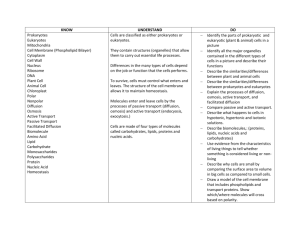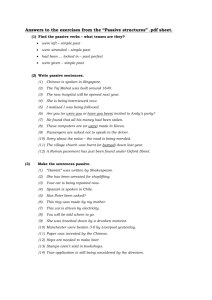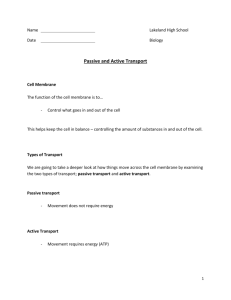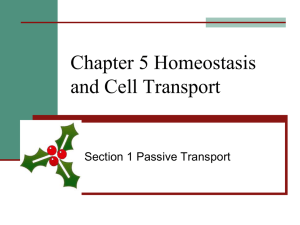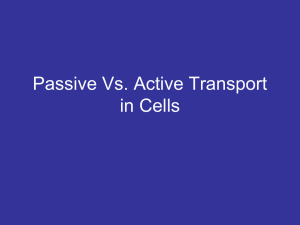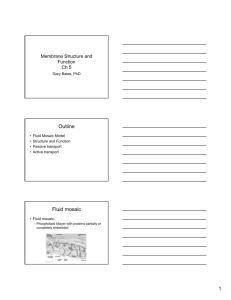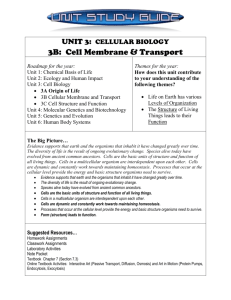Active & Passive Transport Worksheet: Life Science
advertisement
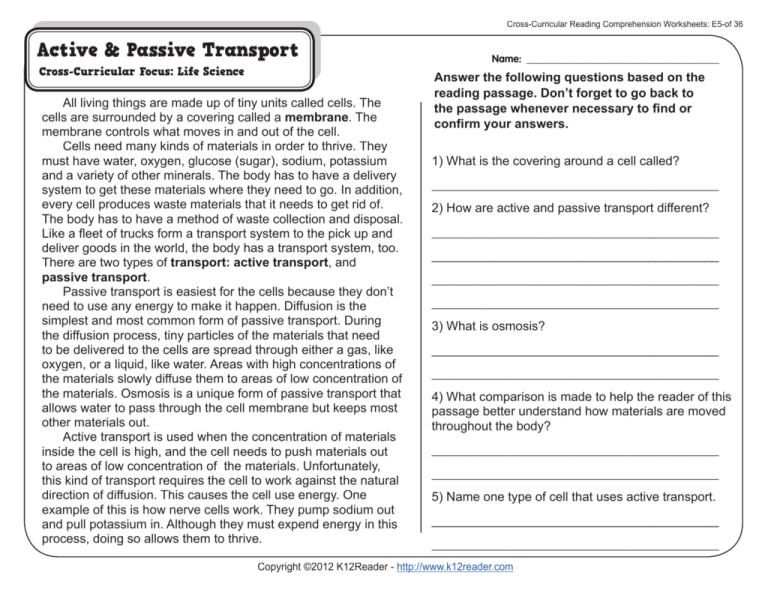
Cross-Curricular Reading Comprehension Worksheets: E5-of 36 Active & Passive Transport Cross-Curricular Focus: Life Science All living things are made up of tiny units called cells. The cells are surrounded by a covering called a membrane. The membrane controls what moves in and out of the cell. Cells need many kinds of materials in order to thrive. They must have water, oxygen, glucose (sugar), sodium, potassium and a variety of other minerals. The body has to have a delivery system to get these materials where they need to go. In addition, every cell produces waste materials that it needs to get rid of. The body has to have a method of waste collection and disposal. Like a fleet of trucks form a transport system to the pick up and deliver goods in the world, the body has a transport system, too. There are two types of transport: active transport, and passive transport. Passive transport is easiest for the cells because they don’t need to use any energy to make it happen. Diffusion is the simplest and most common form of passive transport. During the diffusion process, tiny particles of the materials that need to be delivered to the cells are spread through either a gas, like oxygen, or a liquid, like water. Areas with high concentrations of the materials slowly diffuse them to areas of low concentration of the materials. Osmosis is a unique form of passive transport that allows water to pass through the cell membrane but keeps most other materials out. Active transport is used when the concentration of materials inside the cell is high, and the cell needs to push materials out to areas of low concentration of the materials. Unfortunately, this kind of transport requires the cell to work against the natural direction of diffusion. This causes the cell use energy. One example of this is how nerve cells work. They pump sodium out and pull potassium in. Although they must expend energy in this process, doing so allows them to thrive. Name: ______________________________________ Answer the following questions based on the reading passage. Don’t forget to go back to the passage whenever necessary to find or confirm your answers. 1) What is the covering around a cell called? _________________________________________ 2) How are active and passive transport different? _________________________________________ _________________________________________ _________________________________________ _________________________________________ 3) What is osmosis? _________________________________________ _________________________________________ 4) What comparison is made to help the reader of this passage better understand how materials are moved throughout the body? _________________________________________ _________________________________________ 5) Name one type of cell that uses active transport. _________________________________________ _________________________________________ Copyright ©2012 K12Reader - http://www.k12reader.com Cross-Curricular Reading Comprehension Worksheets: E5-of 36 Active & Passive Transport Cross-Curricular Focus: Life Science All living things are made up of tiny units called cells. The cells are surrounded by a covering called a membrane. The membrane controls what moves in and out of the cell. Cells need many kinds of materials in order to thrive. They must have water, oxygen, glucose (sugar), sodium, potassium and a variety of other minerals. The body has to have a delivery system to get these materials where they need to go. In addition, every cell produces waste materials that it needs to get rid of. The body has to have a method of waste collection and disposal. Like a fleet of trucks form a transport system to the pick up and deliver goods in the world, the body has a transport system, too. There are two types of transport: active transport, and passive transport. Passive transport is easiest for the cells because they don’t need to use any energy to make it happen. Diffusion is the simplest and most common form of passive transport. During the diffusion process, tiny particles of the materials that need to be delivered to the cells are spread through either a gas, like oxygen, or a liquid, like water. Areas with high concentrations of the materials slowly diffuse them to areas of low concentration of the materials. Osmosis is a unique form of passive transport that allows water to pass through the cell membrane but keeps most other materials out. Active transport is used when the concentration of materials inside the cell is high, and the cell needs to push materials out to areas of low concentration of the materials. Unfortunately, this kind of transport requires the cell to work against the natural direction of diffusion. This causes the cell use energy. One example of this is how nerve cells work. They pump sodium out and pull potassium in. Although they must expend energy in this process, doing so allows them to thrive. Key Name: ______________________________________ Answer the following questions based on the reading passage. Don’t forget to go back to the passage whenever necessary to find or confirm your answers. Actual wording of answers may vary. 1) What is the covering around a cell called? membrane _________________________________________ 2) How are active and passive transport different? Active transport moves materials from low _________________________________________ concentration to high an requires energy. _________________________________________ Passive moves from high concentration to low _________________________________________ and does not require energy. _________________________________________ 3) What is osmosis? a type of diffusion that allow water in _________________________________________ but keeps most other materials out. _________________________________________ 4) What comparison is made to help the reader of this passage better understand how materials are moved throughout the body? a fleet of trucks _________________________________________ _________________________________________ 5) Name one type of cell that uses active transport. nerve cells _________________________________________ _________________________________________ Copyright ©2012 K12Reader - http://www.k12reader.com
